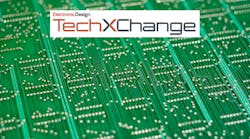DC-DC Converter Draws on the Power of GaN for Passive Cooling
As silicon reaches its physical limits, gallium nitride (GaN) is giving it a run for its money in switching power supplies and other electronics due to its wider bandgap, higher breakdown electric field, and substantially higher electron mobility.
The advantages of GaN power FETs are considerable. They diminish the output charge and gate charge of the chips and virtually eliminate the reverse-recovery charge. Thus, GaN power devices run at faster switching frequencies than silicon, reducing losses and boosting power density in everything from electric vehicles (EVs) to data centers. But the power semiconductor’s unique properties tend to have implications for the whole system.
EV powertrain giant Vitesco Technologies taps into the power-handling benefits of GaN in its latest DC-DC converter for EVs—the Gen5+—setting new standards in power density and heat dissipation compared to its previous liquid-cooled unit. By bringing 650-V GaN power FETs into the fold, the company said it can passively cool the DC-DC converter, eliminating the need for liquid cooling while minimizing overall system costs.
>>Check out the TechXchange and Library Series for similar articles and videos
Vitesco primarily used the GaN power FETs from Infineon Technologies to increase the switching speed of its DC-DC converter—from 100 kHz to more than 250 kHz. This leads to very low switching losses, even in hard-switched half-bridges, while keeping heat to a minimum. Though they require more advanced gate-driver ICs and MCUs for power-supply control, Infineon said its GaN power devices deliver high turn-on and turn-off speeds, and they are housed in TO-leaded top-side cooling (TOLT) packages.
DC-DC Converters: Essential EV Ingredients
The DC-DC converter is one of the core building blocks under the hood of the EV, as it connects the high-voltage battery packs to an increasing number of low-voltage auxiliary systems. In most cases, they act as buck converters, stepping down DC voltages as high as 800 V from the battery pack to 12 V to power headlights, interior lights, wiper and window motors, and 48 V to control steering drives, lighting systems, as well as heating and air conditioning systems.
The 12-V bus has long been the standard DC voltage used by the auxiliary systems under the hood of cars. But the broader industry is upping its standards to 48 V, and DC-DC converters such as those developed by Vitesco are at the heart of the shift. Increasing the DC bus voltage to 48 V from 12 V means 4X less current is used, reducing power losses—and, therefore, heat—due to the resistance on the power rails. Moreover, lowering the current also reduces the thickness, weight, and cost of busbars and cables carrying power inside the EV.
According to TechInsights, the market for automotive-grade DC-DC converters stands at $4 billion. However, it’s projected to grow to approximately $11 billion by 2030, as future EVs drive up the demand by 15% per year.
The GaN power FETs used by Vitesco feature on-resistance (RDS(on)) of 50 mΩ, transient drain-to-source voltage of 850 V, and drain-source current (IDS) of up to 30 A, with a maximum pulse current rating of 60 A. By limiting switching and conduction losses, Infineon said the 650-V GaN power FETs push the power efficiency of the DC-DC converter up to 96% while dissipating less heat, ultimately paving the way for passive cooling.
Said Johannes Schoiswohl, Infineon’s SVP and GM of GaN, “The ultimate value of GaN is demonstrated when it changes paradigms, as in this example of moving from a liquid-cooled system to an air-cooled system.”
The faster switching speeds unlocked by GaN enables the use of smaller capacitors used to smooth out input voltage, transformers to enforce isolation, inductors employed to regulate output voltage and filter out ripple current, and other passives and magnetics. That not only saves space, but it reduces system complexity, too, simplifying mechanical integration and enabling the DC-DC converter to be more flexibly positioned within the EV.
The Gen5+ offers a two-phase output of 248 A at continuous 14.5 V. These phases can be combined to boost output power. It’s also possible to switch off one phase under partial load conditions and interleave the switching frequency between the two phases.
According to Infineon, by switching the input of both phases in series, the 650-V GaN power switches inside it can also be used to build out 800-V power architectures without exceeding the maximum blocking voltage of the device. The unit features an isolated half-bridge topology consisting of a GaN-based half-bridge, a fully isolated transformer, and active rectifier unit for each phase.
Regarding the specific power levels that can be handled by the Gen5+ DC-DC converter, Vitesco said it used GaN to scale the system up to 3.6 kW, while increasing power density to more than 4.2 kW/l, up from 1.5 kW/l in its previous generation.
>>Check out the TechXchange and Library Series for similar articles and videos
About the Author
James Morra
Senior Editor
James Morra is the senior editor for Electronic Design, covering the semiconductor industry and new technology trends, with a focus on power electronics and power management. He also reports on the business behind electrical engineering, including the electronics supply chain. He joined Electronic Design in 2015 and is based in Chicago, Illinois.



